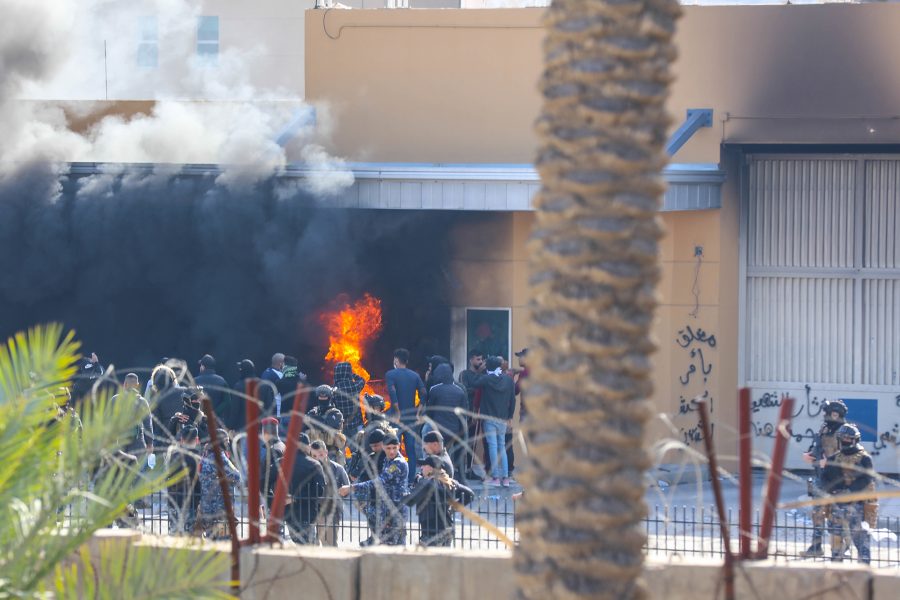The Pentagon will send thousands more US soldiers to the Middle East as tensions skyrocket with Iran following the Jan. 3 targeted killing in Iraq of Tehran’s most prominent military leader.
US forces acted on standing authority to strike Iranian Quds Force commander Qassem Soleimani once he arrived at a “target opportunity,” a senior defense official said. The official would not say when the order was given, but said President Donald Trump gave the order because of recent threats, noting the administration is “confident” the strike was “fully legally justified.”
At least one MQ-9 targeted Soleimani’s vehicle at the Baghdad International Airport following reports of another “imminent threat” against US personnel. Soleimani directed an attack on the US Embassy in Baghdad on Dec. 31 and a US contractor was killed in a Dec. 27 attack in Iraq.
The buildup of forces is in addition to 750 soldiers who had already deployed to Kuwait this week. As that first battalion deployed, the remainder of the brigade was placed on 96-hour notice and is deploying as a “precautionary action” in response to the Iranian threats, according to the official.
The US has been building up combat power in the region since the spring, deploying a “task force” of B-52s, new fighter squadrons, and missile defense systems in response to ongoing Iranian threats. Online flight trackers also have showed a recent influx of additional aircraft, including C-17s and C-5s, flying into the region.
“We want to make sure that we’re prepared for any contingency as this unfolds in the coming days and weeks,” Defense Secretary Mark Esper told reporters Jan. 2 before the strike.
This comes after months of increased Iranian aggression, beginning largely in May on ships in the Persian Gulf. In June, an Iranian surface-to-air missile shot down a US drone over the Strait of Hormuz. Then in July, a US Navy amphibious ship downed an Iranian drone in the Persian Gulf. Over the past two months, the “threat streams operationalized” inside Iraq with the Iranian-backed Kataeb Hezbollah militia targeting US interests.
Photographs of the Jan. 3 drone strike show the burning wreckage of the vehicle that reportedly carried Soleimani and others outside a wall at the airport. The strike also killed Abu Mahdi al-Muhandis, the deputy head of the Iranian-backed Popular Mobilization Forces. The strike was carried out in a manner to avoid collateral damage—on a single vehicle away from civilians and with ordnance that would not inflict further damage, according to officials.
“This strike was aimed at deterring future Iranian attack plans,” the Pentagon statement reads. “The United States will continue to take all necessary action to protect our people and our interests wherever they are around the world.”
The defense official maintained the strike made the region safer and averted upcoming attacks. Iran quickly named Soleimani’s No. 2 the leader of the Quds Force.
Soleimani was a high-profile leader of the Iranian Revolutionary Guard Corps and commander of the Quds Force, rising to power in the Iran-Iraq War of the 1980s. He is connected to the deaths and injuries of hundreds of US service members in the Iraq War through Iranian-backed militias and Iranian-provided weapons.
Iranian leader Ayatollah Sayed Ali Khamenei said in a Twitter statement there will be “severe revenge” for the “martyrdom” of Soleimani.
The US military and State Department are preparing for possible retaliatory acts. On Jan. 3, the State Department urged US citizens to leave Iraq immediately, telling Americans not to approach the Embassy. All consular operations have been halted.
In the aftermath of the strike, the Iraqi parliament has vowed to kick the US out of Iraq, with Mohammed al Halbousi, the speaker of parliament, saying the strike was a “flagrant breach of sovereignty.” Iraqi Prime Minister Adil Abdul-Mahdi in a translated statement said the strike is a “gross violation of the terms of the conditions of the presence of American forces in Iraq and their role.”
The US defense official told reporters that while the American presence is not regulated by a status of forces agreement, and instead by diplomatic agreements between the countries, the “continued coalition activities in Iraq are necessary to US security interests and Iraqi security interests.” The US is monitoring the Iraq parliament’s actions, and is “actively engaged to make sure the coalition’s important de-ISIS work” continues.
Secretary of State Mike Pompeo on Jan. 3 spoke with Halbousi, and the two “agreed on the importance of reducing tensions in Iraq and the region and on working together toward building a sovereign and strong Iraq.” Pompeo also spoke with senior officials in several other nations, including Saudi Arabia, Russia, Afghanistan, Pakistan, China, and others.


